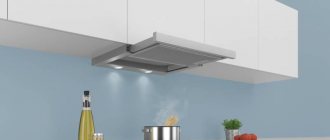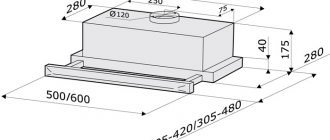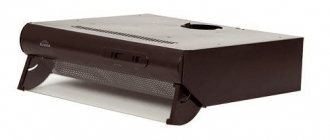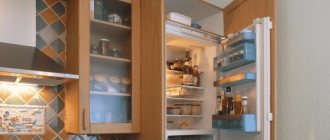A kitchen hood means clean air, pleasant smells, and the ability to spend a long time indoors without fear of high humidity, smoke particles, drops of fat and other harmful impurities. This is bright, adjustable lighting for the hob and the kitchen as a whole. And, above all, it is a design element that attracts many interesting possibilities and style solutions.
Smeg hood
Bosch hood
Korting hood
Standard hood sizes
Main parameters: width
The width of the hood is determined by the width of the hob above which it is mounted - it should be at least the same. Wider ones better capture all the fumes that rise above the hob during the cooking process. For the same reasons, the hood should be placed symmetrically, without moving it to the side.
Conventionally, all hoods can be divided by width into:
- narrow - from 30 to 60 cm;
- standard - from 60 to 90 cm;
- wide - from 90 to 120 cm.
The most common sizes of narrow hoods are 30 cm, 45 cm, 50 cm. They are suitable for a small two-burner hob or a three-burner one.
Among the narrow models presented in the Hausdorf store are: built-in, fireplace, island, wall-mounted and others.
Thus, the 52 cm wide Faber INCA LUX 2.0 EG8 X A52 built into the cabinet has 3 operating speeds and an intensive mode. The Korting KHA 4970 X Cylinder island model, 40 cm wide, has a cylindrical shape and is perfect for a modern, spacious kitchen.
Hoods of standard width are in greatest demand: the width is 60 cm, and it is perfectly suitable for a standard hob. In this category there are models of all types: built-in cabinets, island, wall-mounted.
For example, the 90 cm wide Kuppersberg V 939 ANT Bronze model with bronze finish has 5 power levels and a maximum output of 800 m3/h. The wall-mounted model Korting KHC 97070 GN in black is controlled using a remote control and has a power of 750 m3/h.
Wide hoods have a width of 90 cm and 120 cm. They provide high-quality air purification in a large kitchen, being placed above a standard or non-standard hob. More expensive and productive, they have an original design and immediately catch the eye.
Take, for example, De Dietrich DHD7261B, built into a table with a retractable suction surface 118 cm wide, or wall-mounted Falmec Lumen isola 175 ix (800) ECP with a width of 175 cm and a capacity of 800 m3/h.
Built-in kitchen hood
The names of the type of hood themselves make their feature as clear as possible. Slanted hoods after installation really look like they are tilted towards the wall. A canopy hood really looks like a canopy over a stove. It is logical that a built-in hood should be built in somewhere. This is true!
Dimensions
The built-in kitchen hood is made in such a way that it fits into the kitchen cabinet. To be precise, the hood fits into a special wall cabinet, which is more often called a “wall cabinet above the stove.” The standard, often found, width of such a cabinet is 600 mm. Height - 360 mm, Depth, and this is especially important, 300 mm.
However, there are kitchen furniture sets with other sizes of kitchen cabinets. The size of the cabinet above the stove can be not 600, but 500 mm in length, and its depth can be 300-330 mm, but 250-270 mm.
And here we come to the first, most important criterion for choosing a built-in hood for the kitchen:
The size of the built-in body of the built-in hood should match the size of the cabinet above the stove of your kitchen furniture.
Let me give you an example. We bought a hood for a cabinet whose body was 270 mm wide, and the built-in hood we liked had a built-in body 280 mm wide. As you understand, such a hood will not fit nicely and correctly into such a cabinet.
Related article: Calculation of kitchen hood by room area
built-in hood 280 mm
built-in hood 260 mm
Then it turned out that there are built-in hoods with bodies of 270 and even 260 mm, but that’s a different story. Also note that there are built-in models with a width of 500 mm and even 450 mm. For example, "Krona Kamilla".
Please note that many sellers do not explicitly indicate the dimensions of the hood for embedding, but indicate the dimensions of the visible part.
For example, the Elikor Integra hood. Dimensions as described: width 600 mm, depth 307 mm. In fact, it is important that the dimensions for installing this hood are 496x280 mm.
Hood height
Height is also important: it should be chosen taking into account the type of device and the dimensions of the room. It is recommended to leave a distance of at least 75 cm for a gas stove and at least 65 cm for an electric stove between the surface of the hob and the hood.
By height, all models are divided into:
- low,
- standard,
- tall.
Low models with a minimum height of 10 cm and a maximum of up to 40 cm are usually island or wall-mounted, as well as built-in. For example, the small wall-mounted Kaiser A 501 NB, the most affordable, has a height of 32 cm, and the built-in narrow Elica CIAK GR/A/56 with a retractable panel is 20 cm.
Standard models with heights from 40 to 90 cm - all possible types. Among the most popular is the island model Korting KHA 7950 X Cube, cubic in shape with a height of 72.7 cm.
Tall models up to 140 cm are designed for very large rooms and are considered as a decorative element. Among them there are many fireplace and inclined models, for example, the classic Falmec Melissa Tulip 90 (600) S stained oak 102 cm high with natural wood trim.
Other characteristics of the built-in hood
If you have chosen the size of the hood, you can pay attention to other characteristics of the built-in hood. They are not that important, but they can be interesting.
Visible thickness
In the photo you see that the built-in hood is visible only from its lower part. The standard visible width is 40 mm.
There are hoods for installation, where the width of the visible part is reduced to 20-17 mm. (photo in gallery below)
Hood operating mode
In the article, Choosing a kitchen hood, I wrote that hoods can operate in two modes: recirculation and exhaust. The first mode simply filters the air, the second mode removes air into the kitchen ventilation.
In modern built-in hoods, as a rule, both of these modes are present. That is, the hood has two filters for recirculation (an aluminum grease filter and a carbon odor filter) and has an attachment that allows you to attach a ventilation pipe to the hood to remove air.
Please note that a carbon filter is included by default in any hood. The grease filter may or may not be present.
Hood noise level
The maximum noise level of a built-in hood is indicated in decibels and usually remains unnoticed by the buyer. But in vain.
Related article: Domino hobs: features of selection and installation
I have a hood with a noise level at maximum operating mode of 54 dB. To be honest, it works noticeably loudly. Not like a vacuum cleaner, but the background is noticeable.
According to the standards, the noise level for kitchen appliances that operate intermittently is 75 dB. That is, you can actually find a hood with a noise level of 70-75 dB. And it will be loud.
Hence, another parameter for choosing a built-in hood: the noise level should be as low as possible. 45-50 dB is a good parameter.
Hood performance
The last serious parameter that I advise you to pay attention to is the performance of the hood. It is measured in cubic meters per hour.
In fact, this is the most important parameter of any hood, showing how much air the hood can pump through itself in an hour.
The calculation of this parameter for your kitchen depends on several kitchen parameters and must be calculated separately. You can read how to do this in the article here (after 10/10/2018).
Here I will indicate the simplest option for calculating the required performance of a built-in hood operating in recirculation mode, without exhaust.
Distance from countertop to hood
When installing a 60 cm hood built into a cabinet, there are certain requirements for the distance between the surface of the stove and the panel with the filter.
If the hob or stove is electric, then the height from the countertop to the screen must be at least 650 mm. For gas stoves and mortise surfaces, this distance must be at least 750 mm. By lowering the upper cabinet with a hood below these indicators, the user risks damaging the furniture facade or parts of the kitchen unit body during long-term use. It is also not recommended to place the device too high, otherwise it will not be able to effectively combat air pollution.
When installing a dome hood, you can rely on the same distance from the countertop as for a built-in one.
It should be taken into account that the screens of some models are located too high, so wall and ceiling hoods can be lowered lower.
In addition, the dome is less susceptible to damage from the proximity of the stove than elements of furniture cabinets.
How to choose a built-in hood for a 60 cm kitchen?
Most of our country's population lives in small apartments, where the kitchen area does not exceed 9 square meters. m. In such a small space it is necessary to place all the necessary furniture and equipment. Therefore, the hob surface is often selected with a width of 60 cm. To ensure maximum absorption of contaminated air during cooking, the width of the hood must correspond to the size of the stove. This will ensure maximum productivity of the device. If it is smaller, then it will not be able to fully remove fumes, soot and unpleasant odors from the kitchen area.
A properly selected hood can cleanse the air of harmful impurities and unpleasant odors.
All hoods, depending on the structure of the body, are divided into flat, dome and built-in. A 60 cm flat hood for the kitchen is shaped like a stove, which is attached directly to the wall. It operates in air recirculation mode, purifying it using a built-in filter system. A built-in hood is placed in a kitchen cabinet or countertop. It can be with air outlet into the ventilation shaft or without air outlet. The 60 cm dome hood for the kitchen is the most expensive. It has a massive structure that is attached to the ceiling above the hob. Contaminated air is removed outside the premises.
For a compact room, the most suitable option is a 60 cm built-in kitchen hood. Such models of devices can be mounted in a special hanging box. In this case, you will only be able to see the front narrow panel. The hood can be installed between two wall cabinets. Then the front side of the device can be hidden behind the same material from which the kitchen set is made.
Thanks to their design, built-in hoods can be easily hidden in a kitchen unit. Many models are equipped with a retractable panel, which becomes wider during operation. It turns on automatically when you pull it out. There are models that are built into countertops. They work almost silently. However, such hoods are quite expensive.
Dimensions of the built-in kitchen hood 60 cm
Hood 60 cm built into the cabinet: main selection criteria
The main criterion when choosing a hood model is the performance of the device. It is this indicator that indicates whether the selected model can cope with the task in the kitchen of a specific area. The product passport must indicate the area of the room for which the device model is designed.
The next parameters that need to be taken into account when choosing a hood are energy efficiency and power consumption. Models may have the same power, but different performance. This is due to the design features of the device, the method of air capture and flow generation. All this affects the efficiency of the device.
An important parameter is the noise level. Experts advise giving preference to models whose noise does not exceed a threshold of 50 dB.
The hood cleans the air from food odors, grease and soot
The built-in hood can operate in recirculation mode or be flow-through. Flow hoods remove polluted air into the ventilation shaft of the house. And recirculating ones absorb, purify the air using special filters and return it back to the room.
Helpful advice! Many range hood models are equipped with an anti-return valve. Therefore, there is no need to purchase it additionally for installation of a flow-through hood.
Hoods that operate without venting air into the ventilation of the house are most in demand because they do not require additional installation of an air vent, which in turn takes up space in the kitchen cabinet.
Kitchen hood dimensions 60 cm
Flow hoods are mainly equipped with a metal grease filter, which protects engine elements from grease deposits, and thereby prevents engine damage. If such a filter becomes dirty, it is enough to remove it, wash it and put it back in place.
Recirculating hoods are equipped primarily with carbon filters, which need to be changed periodically. The basis of the filter device is an absorbent in the form of powder or granules, which well absorbs and retains contaminants from the air. Over time, the carbon filter becomes denser, which impairs its absorption properties.
The Russian-made charcoal filter for the Folter hood has proven itself well. It is able to cope with any air pollution and absorbs unpleasant odors well. The filter consists of a galvanized steel housing, inside of which filter material is laid in the form of folds. The material is made of polyester fibers, between which there are small coal granules. Corrugated separators made of aluminum foil are inserted between the folds. This filter requires replacement every 6 months.
The principle of operation of flow and circulation hoods
The Portuguese-made Jet Air carbon filter is suitable for many models of hoods of different brands. It needs to be changed every six months.
Krona hood filters are also very popular among modern consumers. They are designed for 100-130 hours of operation, depending on the intensity of the hood. They are able to provide high-quality air purification and bring it to sanitary standards.
Many consumers prefer Filtero filters, which are easy to install, durable and low cost. The cleaning element consists of peat, stone, impregnated and coconut coal and chemisorbent. They have a high level of filtration and are ideal for inexpensive hoods.
Kitchen hood built into the cabinet
Helpful advice! Some hood models have a warning function. When the filter needs to be replaced, a light comes on on the panel.
Built-in hoods can be with a mechanical or touch control system. Mechanical control is carried out using a single button, which switches the speed of the device and regulates its lighting. The touch panel attracts the buyer's attention with the presence of a display that displays all the data on the operation of the hood. However, it requires more careful care, since even human fingerprints are visible on it, and you can press the button even with the edge of your palm without staining the surface of the hood.
There are models of hoods with a built-in timer and temperature sensor. Some built-in hoods have several speed modes, which allows you to use the device most efficiently.
Hood with touch control
Safety support should not be overlooked when the hood and boiler or water heater operate together. The main danger of simultaneous operation of these devices is the formation of reverse draft and the entry of carbon monoxide back into the room from the smoke shaft. The conditions for joint work must be indicated in the product passport.
Advantages and disadvantages of a 60 cm built-in kitchen hood
Why you should give preference to a 60 cm built-in kitchen hood over a dome or hanging analog will help explain the pros and cons of this type of device.
Advantages:
- the design of the built-in hood allows it to blend into the interior and be invisible to prying eyes;
- the device takes up minimal space, which is important for small kitchens;
Kitchen interior with built-in hood
- The hood consumes little electricity and operates quietly.
- Flaws:
- has low power due to its compact design, which affects the performance of the device;
- has a limited range compared to dome hoods.











